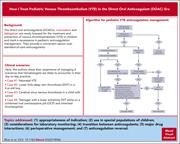Issue Archive
Table of Contents
BLOOD COMMENTARIES
HOW I TREAT
How I treat pediatric venous thromboembolism in the DOAC era
Clinical Trials & Observations
Since the US Food and Drug Administration’s recent approval of rivaroxaban and dabigatran for use in children, pediatric hematologists are using these direct acting oral anticoagulants (DOACs) more frequently. This timely How I Treat article by Bhat et al explores 4 cases that highlight the issues associated with using DOACs, proving helpful evidence- and experience-based advice about how, when, and why to use these effective agents in situations peculiar to neonates, infants, and adolescents.
CLINICAL TRIALS AND OBSERVATIONS
Two-year follow-up of lisocabtagene maraleucel in relapsed or refractory large B-cell lymphoma in TRANSCEND NHL 001
Clinical Trials & Observations
CD19-directed chimeric antigen receptor (CAR) T cells for large B-cell lymphomas are changing the treatment landscape for patients with relapsed disease, but the emphasis in most reports to date has been on response rates and 1-year durability of outcomes. Mature 2-year outcomes of the phase 2 TRANSCEND trial of lisocabtagene maraleucel in patients with progressive disease beyond 2 lines of therapy are reported by Abramson et al, indicating 40% progression-free and 50% overall survival, with 37% persistence of CAR T cells. One-third of patients experienced prolonged cytopenia beyond the first month while most patients had persisting severe hypogammaglobulinemia at 2 years posttreatment.
Phase 2 study of inotuzumab ozogamicin for measurable residual disease in acute lymphoblastic leukemia in remission
Clinical Trials & Observations
Brief Report
Inotuzumab ozogamicin (InO) is a CD22-targeting monoclonal antibody conjugated to the toxin calicheamicin. Jabbour et al report on a 26-patient phase 2 trial of its use for measurable residual disease (MRD) in patients with B-cell acute lymphoblastic leukemia (B-ALL) in first or second complete remission. The authors’ data indicate an MRD conversion rate of 69%, with 2-year relapse-free survival of 54% and 2-year overall survival of 60%, potentially expanding the role InO can play in the management of B-ALL.
Old rivals become new friends
Clinical Trials & Observations
LYMPHOID NEOPLASIA
Early complete response as a validated surrogate marker in extranodal marginal zone lymphoma systemic therapy
Clinical Trials & Observations
The indolent non-Hodgkin lymphoma, extranodal marginal zone lymphoma, has a long natural history and favorable survival, so surrogate end points are needed if improved therapies are to be developed. By analyzing a large mature phase 3 trial, Bommier and colleagues identified that both complete response (CR) measured by computed tomography at 2 years and time to achievement of CR within 2 years were associated strongly with being progression free at 8 years, and that as surrogate measures, they explained 90-95% of long-term outcomes. The authors’ work identified these 2 measures as validated surrogates for future trials.
Epstein-Barr virus–encoded EBNA2 downregulates ICOSL by inducing miR-24 in B-cell lymphoma
Leopizzi et al have identified 2 novel functions of the Epstein-Barr virus (EBV) nuclear antigen-2 (EBNA2), which appear to be operative in the context of a subset of EBV-associated B-cell lymphomas. The authors reveal that EBNA2 induces the long nonencoding microRNA miR-24, which in turn both enhances MYC levels and reduces expression of inducible costimulator ligand (ICOSL), thereby reducing host immune responses. Silencing of miR-24 reconstitutes tumor immunogenicity and induces apoptosis in diffuse large B-cell lymphoma cells in vitro.
THROMBOSIS AND HEMOSTASIS
Reciprocal stabilization of coagulation factor XIII-A and -B subunits is a determinant of plasma FXIII concentration
Coagulation factor XIII (FXIII) serves a unique enzymatic function in stabilizing fibrin, playing key roles in the hemostatic process, healing wounds, and the maintenance of pregnancy. Byrnes and colleagues report on an elegant series of experiments, in mice and humans, which explored how the subunits of FXIII reciprocally stabilize each other in circulation. The authors’ findings help explain the functional basis of some FXIII deficiencies and have important implications for the development of new therapies for this condition.
TRANSFUSION MEDICINE
Regulation of kynurenine metabolism by blood donor genetics and biology impacts red cell hemolysis in vitro and in vivo
Nemkov et al performed a detailed metabolomics analysis of donated red cells and correlated their findings with genetics and hemolysis in recipient patients. The authors identified that kynurenine is a marker of osmotic fragility and that polymorphisms in SLC7A5 and ATXN2 are associated with kynurenine levels in stored red cells as well as hemoglobin increments and in vivo hemolysis upon transfusion. Their data enhance our understanding of red cell storage lesions and transfusion outcomes.
BLOOD WORK
ERRATUM
-
Cover Image
Cover Image
![issue cover]()
Vibrant red staining shows expression of Epstein-Barr virus–encoded EBNA2 in nongerminal center diffuse large B-cell lymphoma. The viral protein, by increasing miR-24, downregulates the inducible costimulator ligand and facilitates immune evasion. See the article by Leopizzi et al on page 429.
- PDF Icon Front MatterFront Matter
- PDF Icon Table of ContentsTable of Contents
- PDF Icon Back MatterBack Matter
- PDF Icon Editorial BoardEditorial Board
Advertisement intended for health care professionals
Email alerts
Advertisement intended for health care professionals










Two years later: CD19 CAR-T going the distance
Clinical Trials & Observations